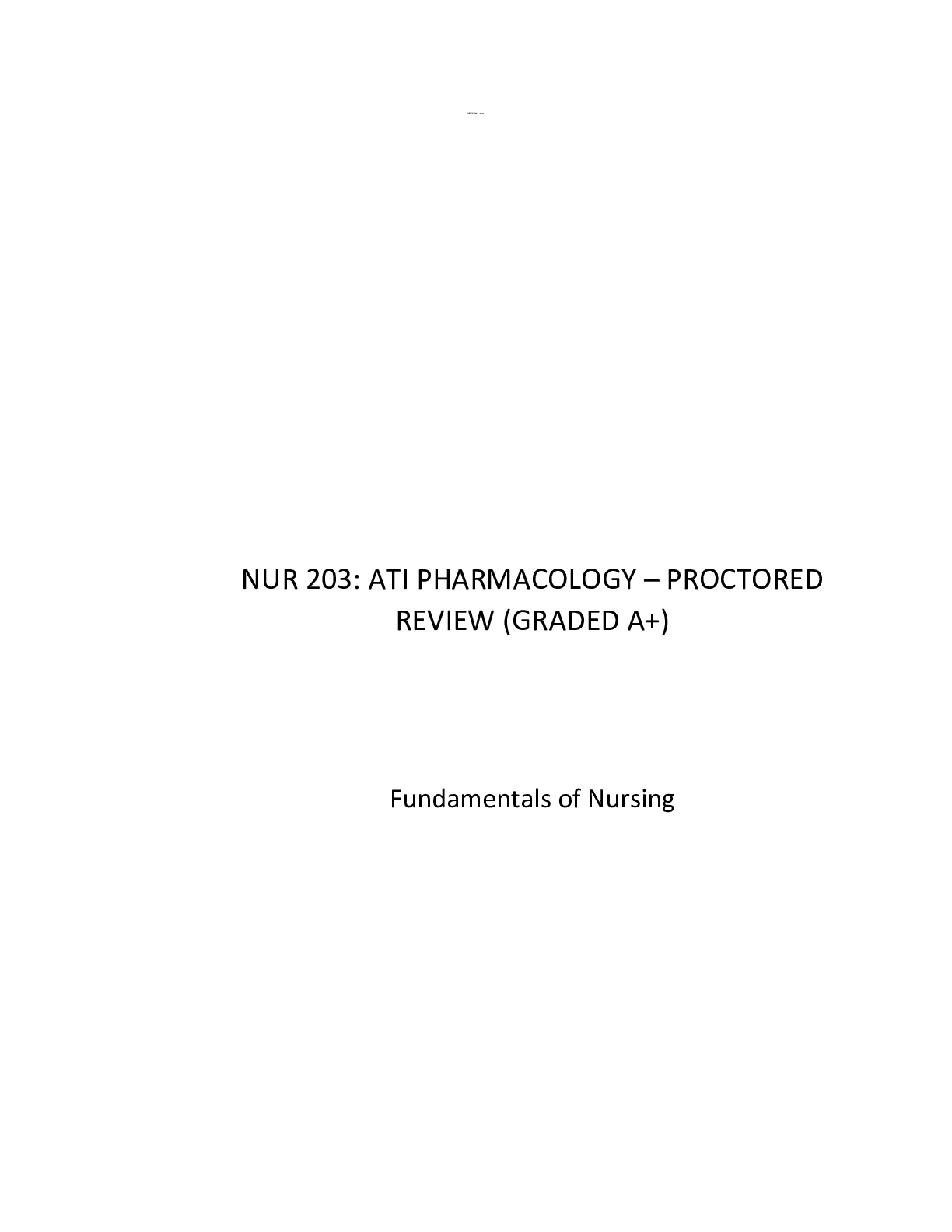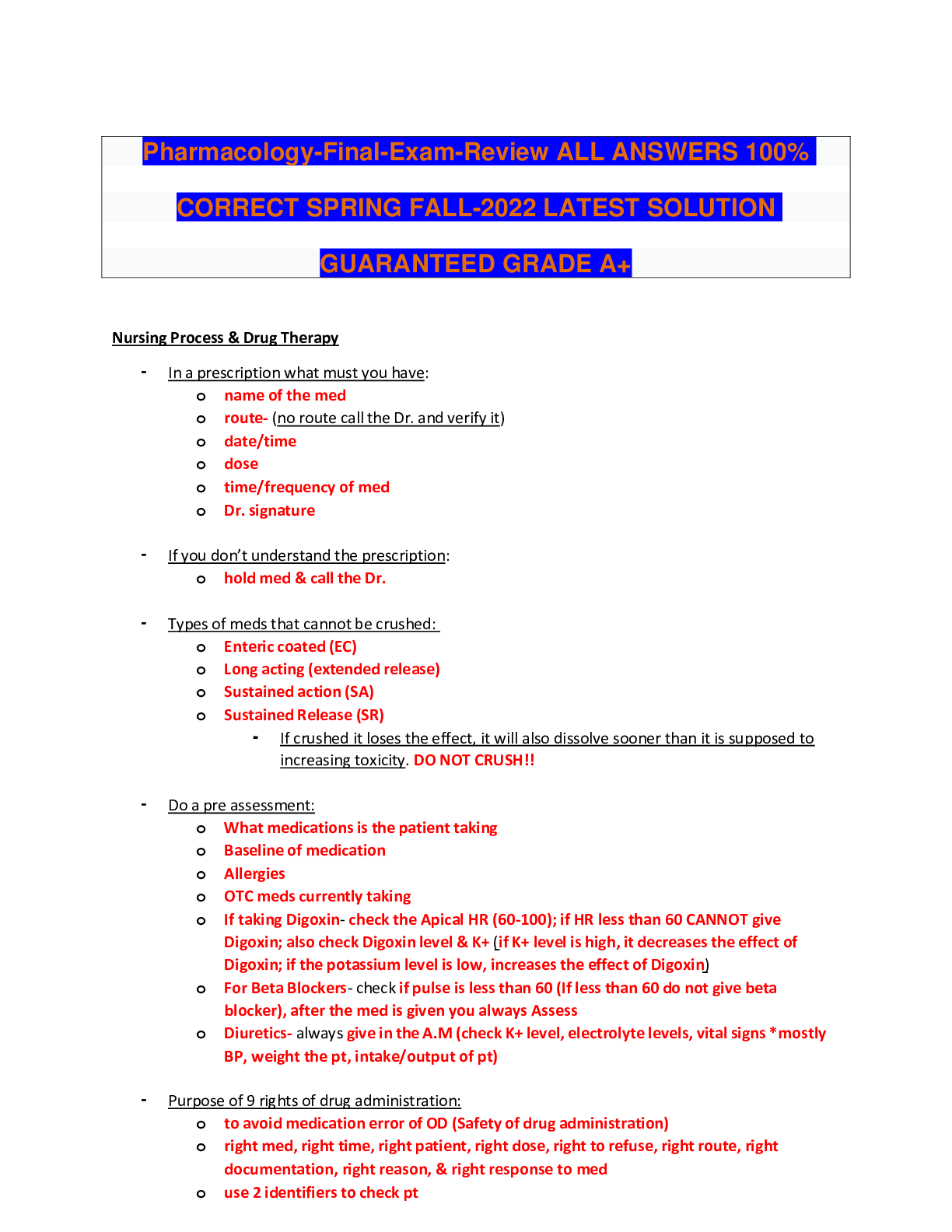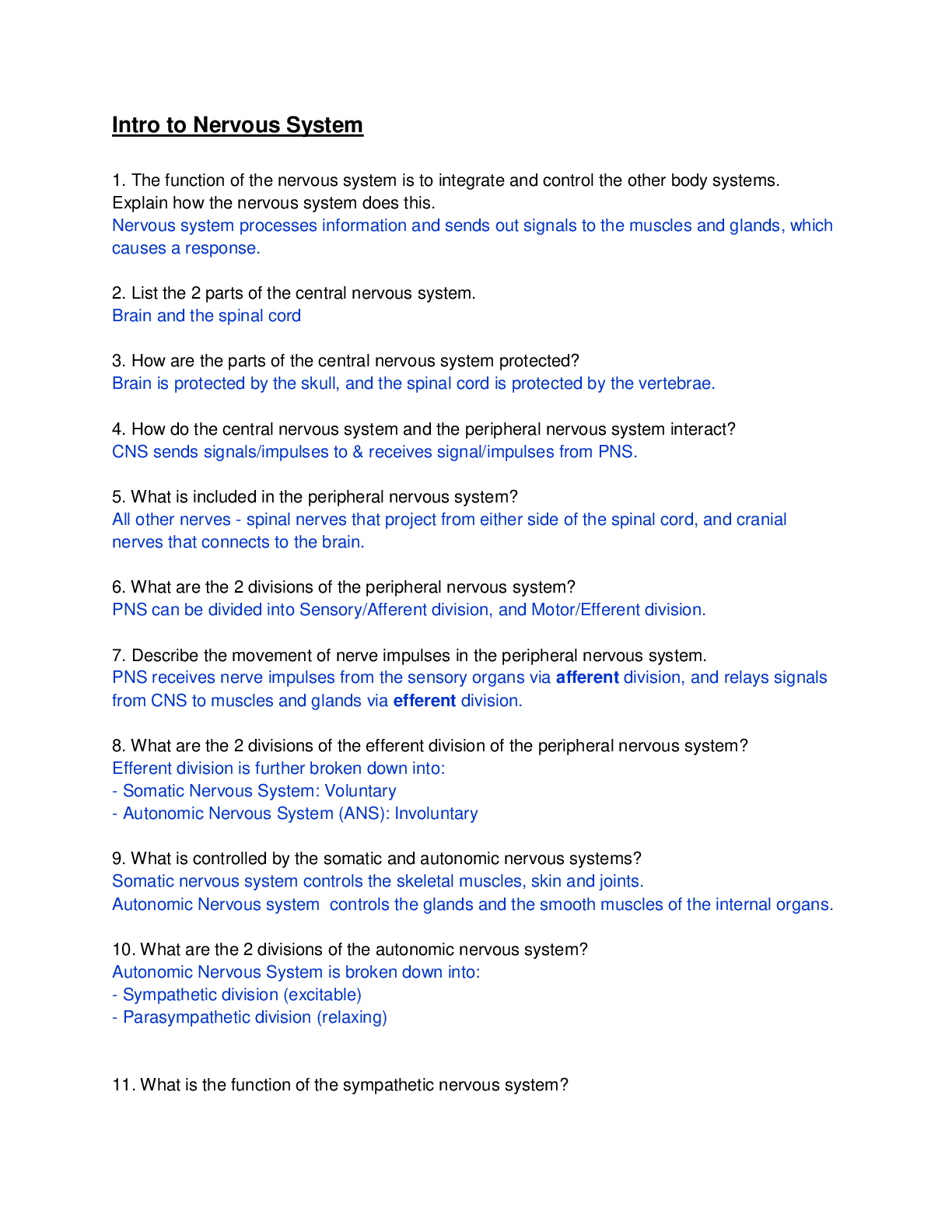*NURSING > EXAM REVIEW > MED SURG EXAM 3: A Comprehensive Review (All)
MED SURG EXAM 3: A Comprehensive Review
Document Content and Description Below
MED SURG EXAM 3 ENDOCRINE DISORDERS (CH 52) ADRENAL + PITUITARY DISORDERS PITUITARY GLAND -Abnormalities of the anterior and posterior portion of the gland may occur independently -Hypofunction o... f the pituitary gland (hypopituitarism) can result from disease of the pituitary gland itself or of the hypothalamus (result is essentially the same) -hypopituitarism can result from radiation therapy to the head + neck -Total destruction of pituitary gland (ex. by trauma or tumor) removes all stimuli that are normally received by thyroid, gonads, and adrenal glands. Result is extreme weight loss, emaciation, atrophy of all endocrine glands + organs, hair loss, impotence, amenorrhea, hypometabolism, and hypoglycemia…Coma + death occur if missing hormones are not replaced ANTERIOR PITUITARY -TSH, ACTH, FSH, and LH release hormones from other endocrine glands -Prolactin acts on the breast to stimulate milk production -GH protein hormone that increases protein synthesis in many tissues, increases the breakdown of fatty acids in adipose tissue, and increases the glucose level in the blood (these actions of GH are essential for normal growth) Oversecretion: • ACTH (Cushing’s) • “Cushing’s syndrome – elevated cortisol level; blood sugar may be high” • Basophilic tumors giv • rise to Cushing syndrome with features highly attributable to hyperadrenalism, including masculinization and amenorrhea in females, truncal obesity, HTN, osteoporosis, and polycythemia • GH (acromegaly) • Acromegaly = excess of GH in adults, results in enlargement of peripheral body parts without an increase in height • Oversecretion of GH in children results in gigantism, person may grow up to 7 or 8 feet tall • “Acromegaly – hypersecretion of GH; everything will be overdeveloped – a lot of cardiac complications * – sometimes they cannot see properly – enlarged extremities, forehead – female – might have issues with periods, anuria, or unable to have babies” • • Eosinophilic tumors that develop early in life result in gigantism – person may be over 7 ft. tall + large in all proportions, but so weak + lethargic that can barely stand. If the disorder begins during adult life, the excessive skeletal growth occurs only in the feet, hands, superciliary ridge, molar eminences, nose, chin, giving rise to ACROMEGALY. Insufficient secretion: – GH (dwarfism) • Dwarfism = insufficient secretion of GH during childhood results in generalized limited growth • “Dwarfism – undersecretion of GH; other glands will be underdeveloped” – Panhypopituitarism undersecretion commonly involving all of the anterior pituitary hormones • Atrophy (shrining) of the thyroid gland, adrenal cortex, & gonads (b/c of loss of the tropicstimulating hormones) • “everything is going to be decreased/diminished as a result” POSTERIOR PITUITARY - vasopressin (ADH) + oxytocin = hormones secreted by posterior lobe of pituitary gland; stored in the post. pit. but synthesized in the hypothalamus - ADH = controls excretion of water by the kidney; ADH secretion is stimulated by: an increase in osmolality of the blood or be a decrease in BP - Oxytocin – secretion is stimulated during pregnancy + childbirth; facilitates milk ejection during lactation & increases contractions during labor + delivery Diabetes Insipidus (DI) LOW ADH • “DI = posterior pituitary is not producing enough ADH (vasopressin); patient will be eliminating a lot of diluted urine (about 250 mL of urine an hour) so you need to give the vasopressin” • too little ADH = will eliminate a lot of fluid Syndrome of Inappropriate Antidiuretic Hormone (SIADH) secretion HIGH ADH • “a lot of fluid accumulation” • too much ADH = will retain a lot of fluid DIABETES INSIPIDUS • Patho: Deficiency of ADH decreases the collecting and distal renal tubules ability to concentrate urine excessive diluted urine, excessive thirst, & excessive fluid intake • “kidney is going to be affected by this lack of vasopressin • patients will be very thirsty + require a lot of water b/c losing a lot of urine • Causes: may occur following surgical TX of a brain tumor, secondary to nonsurgical brain tumors, traumatic brain injury, infections of the nervous system, post hypophysectomy, failure of renal tubules to respond to ADH, and use of specific meds • Risk Factors: o Head injuries and infections o Lithium* or demeclocycline use *TQ: Lithium affects vasopressin, has a relationship with this hormone Google: Nephrogenic diabetes insipidus (NDI) is the most common renal side effect of lithium therapy Another cause of DI is failure of the renal tubules to respond to ADH; this Nephrogenic form may be related to hypokalemia, hypercalcemia, and a variety of medications (ex. lithium or demeclocycline) • Clinical manifestations o Enormous daily urine output (greater than 250 mL/hr) o Very dilute urine (specific gravity of 1.001-1.005) inability to increase the specific gravity + osmolality of urine is characteristic of DI o Intense thirst (pt. tends to drink 2-20 L of fluid daily – craves cold water) o Urine does not contain abnormal substances like glucose or albumin o Weight loss o Increasing serum osmolality o Elevated sodium levels • Medical Management o ADH replacement (Vasopressin, DDAVP) usually a long-term therapeutic program DDAVP = Desmopressin a synthetic vasopressin w/o the vascular effects of natural ADH; admin. intranasal Vasopressin causes vasoconstriction (use cautiously w/ CAD pts) o Administer diuretic “ONLY if the patient is compromised with CHF…this issue is not related to diuretic; it is related to vasopressin so give vasopressin to control elimination of the diluted urine!” o Low Na diet there is a lot of sodium accumulation – (action of ADH is on the distal tubule (not proximal) so only water leaves) give low sodium diet for DI patients! IF DI is renal in origin, the other TXs are ineffective – thiazide diuretics, mild salt prep, and prostaglandin inhibitors are used to treat the Nephrogenic form of DI o Increase fluid intake (ensure adequate fluid replacement) *Disease cannot be controlled by limiting fluid intake b/c high-volume fluid loss of urine continues even without fluid replacement. Attempts to restrict fluids cause patient to have insatiable craving for fluid and development of hypernatremia and severe dehydration • Nursing Management o I & O and daily weights o Monitor neuro status, VS o No caffeine “caffeine triggers more fluid elimination” o Monitor and manage fluid & electrolyte balance (retaining Na) [Show More]
Last updated: 2 years ago
Preview 1 out of 56 pages

Buy this document to get the full access instantly
Instant Download Access after purchase
Buy NowInstant download
We Accept:

Reviews( 0 )
$12.50
Can't find what you want? Try our AI powered Search
Document information
Connected school, study & course
About the document
Uploaded On
Aug 03, 2021
Number of pages
56
Written in
Additional information
This document has been written for:
Uploaded
Aug 03, 2021
Downloads
0
Views
90








